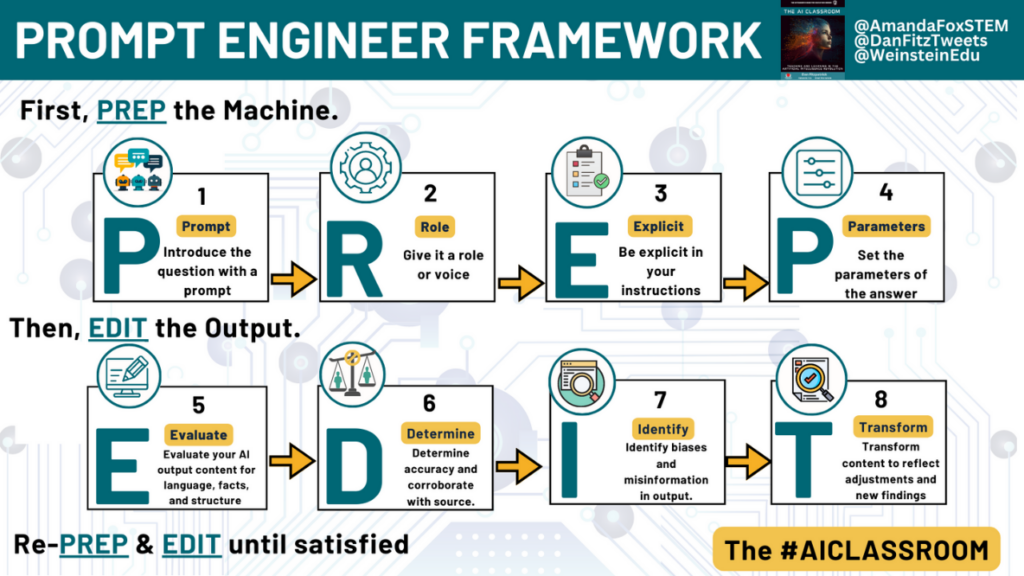In this blog, we will guide you through your initial journey into the realm of generative Artificial intelligence—starting from account creation to having your first conversation with an AI. Along the way, we’ll make you aware of the progression steps to take and the policies you should be aware of.
Contents
- ChatGPT basics
- Creating a ChatGPT account
- My First Prompts
- Looking at a Prompt framework
- Feedback on your Prompts and Responses
- Policies you should be aware of
ChatGPT Basics
Unlike Google searches where you ask it to find a list of websites that might answer your question, ChatGPT uses the information available on the internet, circa 2021, to provide you an answer. Again, unlike Google searches, using Chatgpt is a conversation between you and the AI, it consists of two parts:
- The prompt – the question you are looking for answers to
- The response – the answer the AI produces
Using your prompts you can discuss and refine its responses until you have the answers you need, all in plain language, no coding required.
Think of ChatGPT as a super-smart friend who can assist you with a variety of tasks, such as crafting emails, developing business plans, and designing lesson activities or handouts.
Always check the responses for accuracy and bias.
Because Chat GPT is not always accurate, it is essential to establish if a response is correct.
But why is it not always accurate?
AI is like us it can get confused when it tries to understand something but will always try to answer a question and can even make things up! This is called a hallucination.
ChatGPT’s knowledge is not up to date, it was trained on data up to 2021 and doesn’t have internet access.
ChatGPT’s responses reflect the biases of the internet data it was trained on. Its algorithm uses the main viewpoints as its guide when providing a response to your prompt. This means if specific people’s views or facts are underrepresented within its data then it is unlikely it will reflect this in its answer regardless of whether they are more accurate or relevant to your conversation. If more people said the earth was flat then so would ChatGPT!
In summary, all AI responses should not be taken at face value and should be checked for accuracy and bias by researching other sources.
Sign up to ChatGPT
Now you are signed up It’s time to get prompting. ChatGPT is something you should just have a go at, you can’t break it and there is no right or wrong; the more you use it the better you will get.
My First Prompts
To help you get started we have provided some simple prompts below which you can use in chatGPT to help with your workflows. Replace any of the bold text with the subjects you want responses for.
Why not try this simple prompt to help with proofreading work that lets you provide a target audience and see why it has suggested the changes:
Proofread the text below and make suggestions on sentence structure spelling and grammar. Include a clear explanation of your suggested changes. Your target audience is level 2 further education students. Paste yout text here
Need some new ideas for class activities how about this simple prompt:
You are a math teacher at a further education college in the uk. You are teaching a lesson on areas as part of the A Level syllabus provide me some fun and creative lesson activities that you might use.
ChatGPT can help you get started investigating new topics try this simple prompt below:
“I am a Contracts officer help me explore the theme of Data sharing by providing its core concepts around GDPR legislation. create a table of their similarities and differences and then explain them in simple terms.”
The second prompt is a useful follow-up to build on your existing knowledge from the previous response and dig a little deeper into the theme.
“Building on the topics in your last response explore additional topics. Provide a table of topics, their similarities and differences and explain how they relate to the previous topics and to each other in simple terms.”
Why not try and write some simple prompts of your own?
Prompt Engineer Framework
As you start to develop your AI skills with more complex prompts a useful methodology is Dan Fitzpatrick’s Engineer Framework.

Here is an example of a prompt using this method:
- P = Create a lesson plan
- R = You are a … teacher working at a further education college
- E = Create a lesson plan for a lesson for a Level … course in… introducing the key principles of …
The lesson will be for 2 hours with 14 learners it should include a variety of activities of differing group sizes. The activities should be varied and move up Bloom’s taxonomy as the lesson progresses to deepen the learning experience.
Each activity must provide clear observable outcomes and opportunities for sharing with the wider group. Indicate timings and resources for each activity.
Provide stretch and challenge activities for groups that may complete tasks ahead of other groups. - P = Write in English (United Kingdom) using clear headings, and bullet points.
Feedback on your Prompts and Responses
Have you been using ChatGPT already? If so we would like to hear from you. What are your best prompts and the responses you have got from using ChatGPT; let us know in this quick survey which you can access by selecting the image below.

Policies
Below you will find links to relevant policies the college has with regard to AI, Assessments and Plagiarism, take a look and make sure you and your students proceed accordingly.
Help and Support

As always contact the Digital Learning Team for more information, guidance, and support.

